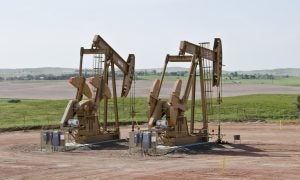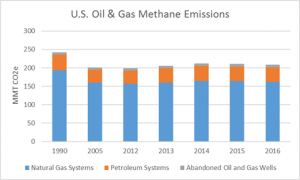EPA inventory shows U.S. oil & gas methane emissions remain a major problem
 The U.S. Environmental Protection Agency (EPA) has released a draft of its annual update to the U.S. Inventory of Greenhouse Gas Emissions (GHGI). The draft, which now includes emissions data for 2016, estimates oil and gas operators released 8.1 million metric tons (MMT) of methane of the course of the year through leaks, venting, and incomplete combustion—a mere one percent reduction from 2015.
The U.S. Environmental Protection Agency (EPA) has released a draft of its annual update to the U.S. Inventory of Greenhouse Gas Emissions (GHGI). The draft, which now includes emissions data for 2016, estimates oil and gas operators released 8.1 million metric tons (MMT) of methane of the course of the year through leaks, venting, and incomplete combustion—a mere one percent reduction from 2015.
EPA’s estimates of annual oil and gas methane emissions are likewise essentially flat from 2005 to 2016, showing a three percent increase. While some industry groups like to highlight the 15 percent decrease in emissions from 1990 to 2016, this ignores the fact that emission estimates have hovered around 8.1 MMT for the last dozen years, having roughly the same near-term climate impact every year as the emissions of 167 coal-fired power plants. Recent science has also suggested that methane is even more potent over twenty years than previously thought; the newer science suggests these emissions pack 14 percent more warming power, and are equivalent to more than 190 coal-fired power plants.
It’s also critical to understand that, as alarming as these numbers are, they fail to account for a large portion of oil and gas emissions. As discussed below, emerging science is pointing to the fact that actual emissions are substantially higher than estimated by EPA.
[Tweet “EPA inventory shows U.S. oil & gas methane emissions remain a major problem”]
Component-level measurement leaves uncertainty
Previous research has found that inventories such as the EPA GHGI that are based primarily on component- or equipment-level measurements tend to underestimate emissions. For example, Barnett Shale well pad emission estimates based on empirical, site-level data were 50 percent higher than an equipment-based inventory. This and other studies indicate that the EPA GHGI is underestimating oil and gas methane emissions, particularly due to malfunctions and other avoidable process conditions causing high emission rates.
Much of the one percent decrease from 2015 to 2016 was due to fewer well completions and less associated gas flaring, meaning the small emission reductions were apparently a product of lower commodity prices resulting in less drilling and production rather than deliberate efforts to control emissions.
This year was the first time EPA included emissions from abandoned oil and gas wells. They estimate that the approximately three million abandoned wells in the country emit 0.3 MMT of methane per year. Although this is a relatively small fraction of total emissions from the oil and gas industry, it is still a substantial amount and there are existing solutions to mediate this, such as plugging abandoned wells.
Methane emissions are a major but solvable problem
The technologies and operational best-practices to mitigate methane emissions are available now.
The environmental case for natural gas hinges on getting emissions down as low as possible. The International Energy Association (IEA) says we can cut up to half of global methane emissions at zero net cost. Addressing methane emissions now is still the easiest and quickest way to slow the rate of warming.
[1] The EPA has not reported individual year emissions from 1990 – 2012.
Image via Flickr/Tim Evanson












